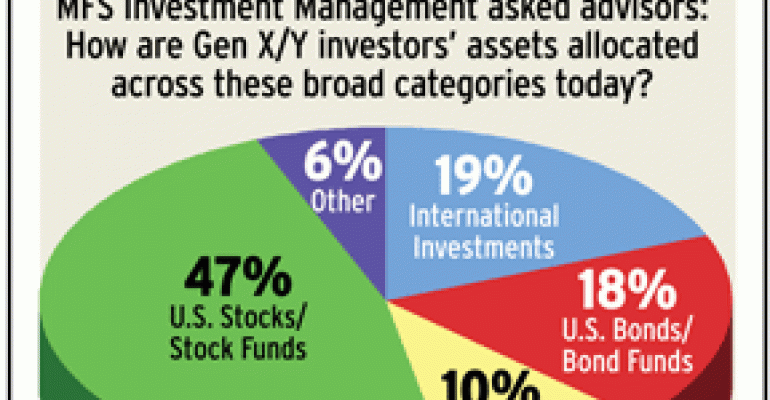Over the last year or so, advisors have been struggling to get their clients out of cash, but how much cash are your clients really holding? Investors say they’re holding 27 percent of their investable assets in cash, according to an MFS Investment Management survey of 929 investors. Generation Y investors lead the pack, allocating 33 percent to cash, up from 30 percent in February. Guess what financial advisors who were surveyed thought their younger clients held in cash? On average, advisors surveyed believe Generation X/Y investors held 10 percent in cash. Babyboomers? FAs thought boomers held 14 percent in cash.
Generations X and Y have a combined $2.6 trillion in spending power and are larger than the baby boomers, according to Iconoculture, but they’re more focused on saving than investing their money in equities. Fifty percent of all investors surveyed said they were a “saver” more than an “investor,” with 63 percent of Gen Y respondents answering this way.
William Finnegan, senior managing director and head of U.S. marketing for MFS, said the change will require advisors to improve their communication process with clients; turn more to social media to reach younger investors; and create portfolios that are more personal and customized, rather than “canned.” Investing strategy and portfolios will also have to be better explained, he added.

“Investors are providing clear direction and it does not match conventional wisdom,” Finnegan said in a statement. “Investors, many with a defensive mindset, will likely continue to reject traditional investment recommendations from their advisors. They expect a plan that is specific to them, customized not only to their goals, but one that also addresses their broader economic concerns along with their individual market experience.”
But investors’ cash is not sitting in their brokerage accounts—“on the sidelines”—waiting to be invested. Rather, investors, especially younger generations, are holding it in bank accounts. According to MFS’s June survey, the mean percent of cash held in banks or credit unions was 65.4 percent for all investors, versus 31.7 percent held at brokerage firms.
The New Normal
On the one hand, advisors have a number of clients (baby boomers) entering the distribution phase of their lives, and at the same time, they have this new group of investors (Gen Y) coming in that is scared to invest, indicated by the 33 percent in cash, Finnegan said. He calls this younger group “recession babies,” because their parents were crushed by the recent recession, and they do not want this to happen to them. For this crowd, volatility is essentially all they’ve known since they have come of age, Finnegan added.
The younger generation is also more pessimistic about retirement and the stock market. Fifty-two percent of Gen Y investors said they will never feel comfortable investing in the stock market, up from 40 percent in May of this year. In addition, 67 percent of Gen Y respondents said they are more concerned than ever about being able to retire when they thought they would, versus 54 percent in May. This compares to 66 percent of boomers.
Generations X and Y are more focused on protecting principal and generating income, although advisors don’t perceive these as top investment objectives for these investors. According to the survey, 30 percent of Gen X/Y said their most important investment objective was to protect principal, versus 16 percent of advisors. Meanwhile, 29 percent of Gen X/Y said generating income was most important, compared to 2 percent of advisors. Protecting savings and investments was the top way Gen X/Y investors indicated they’d like to be supported, but only 17 percent of advisors expected this to be a top concern for this age group.


